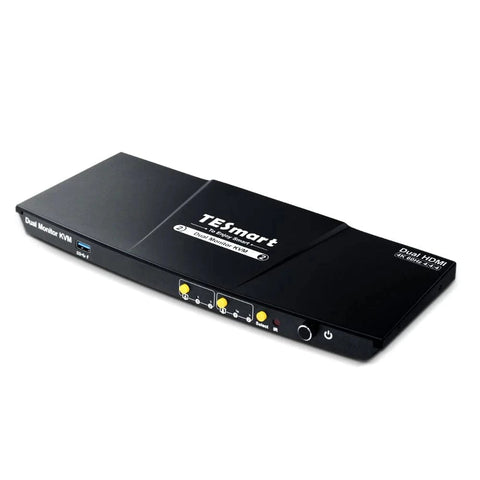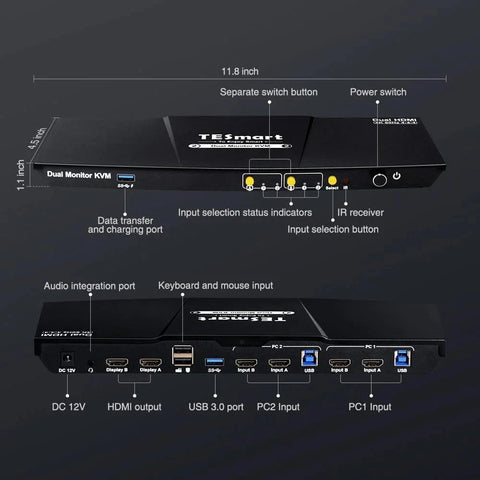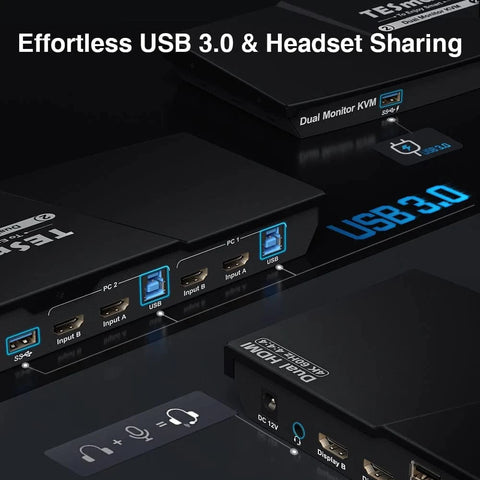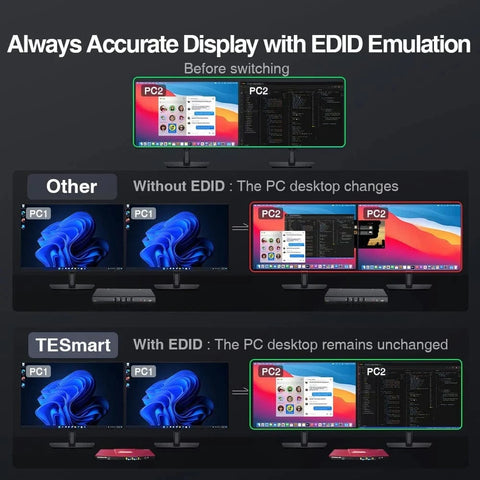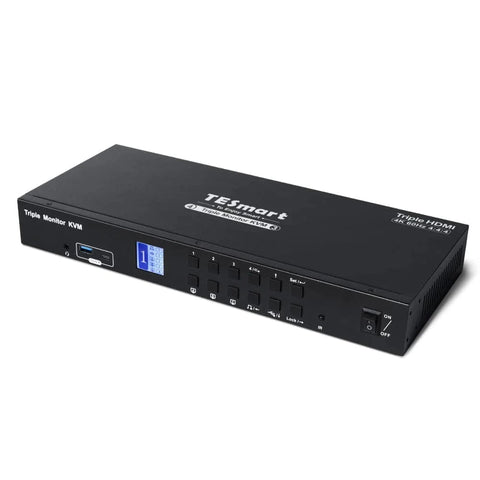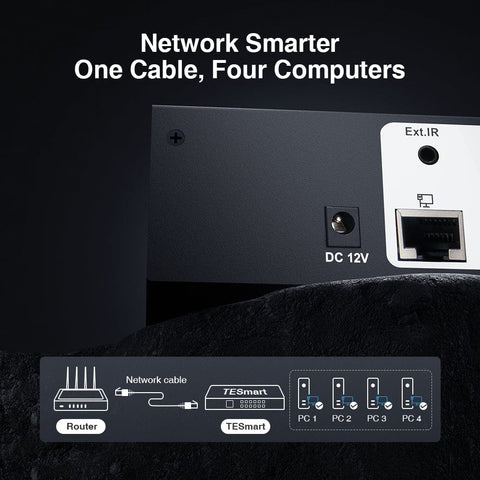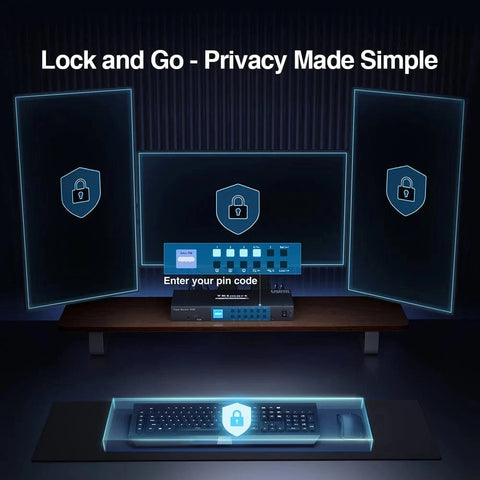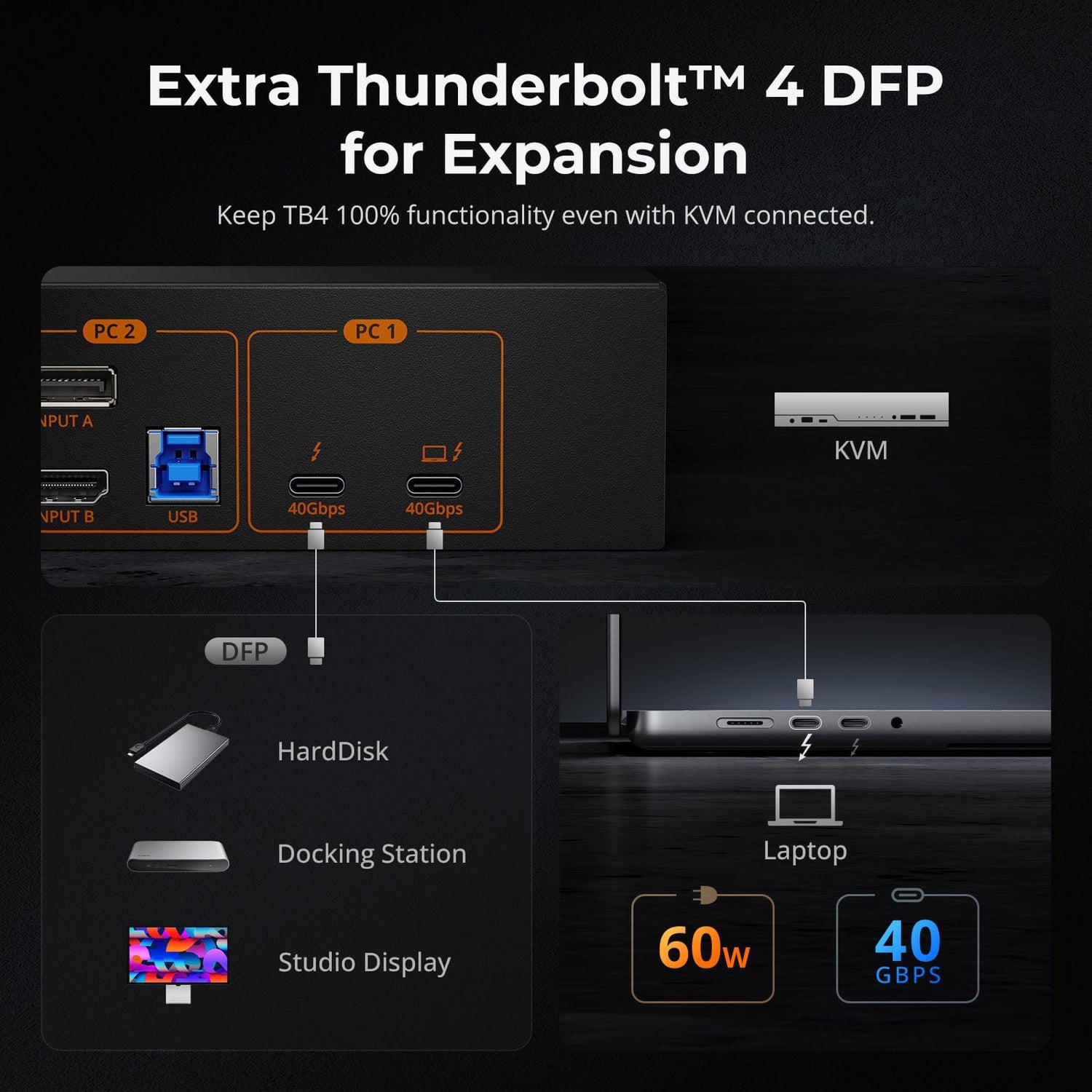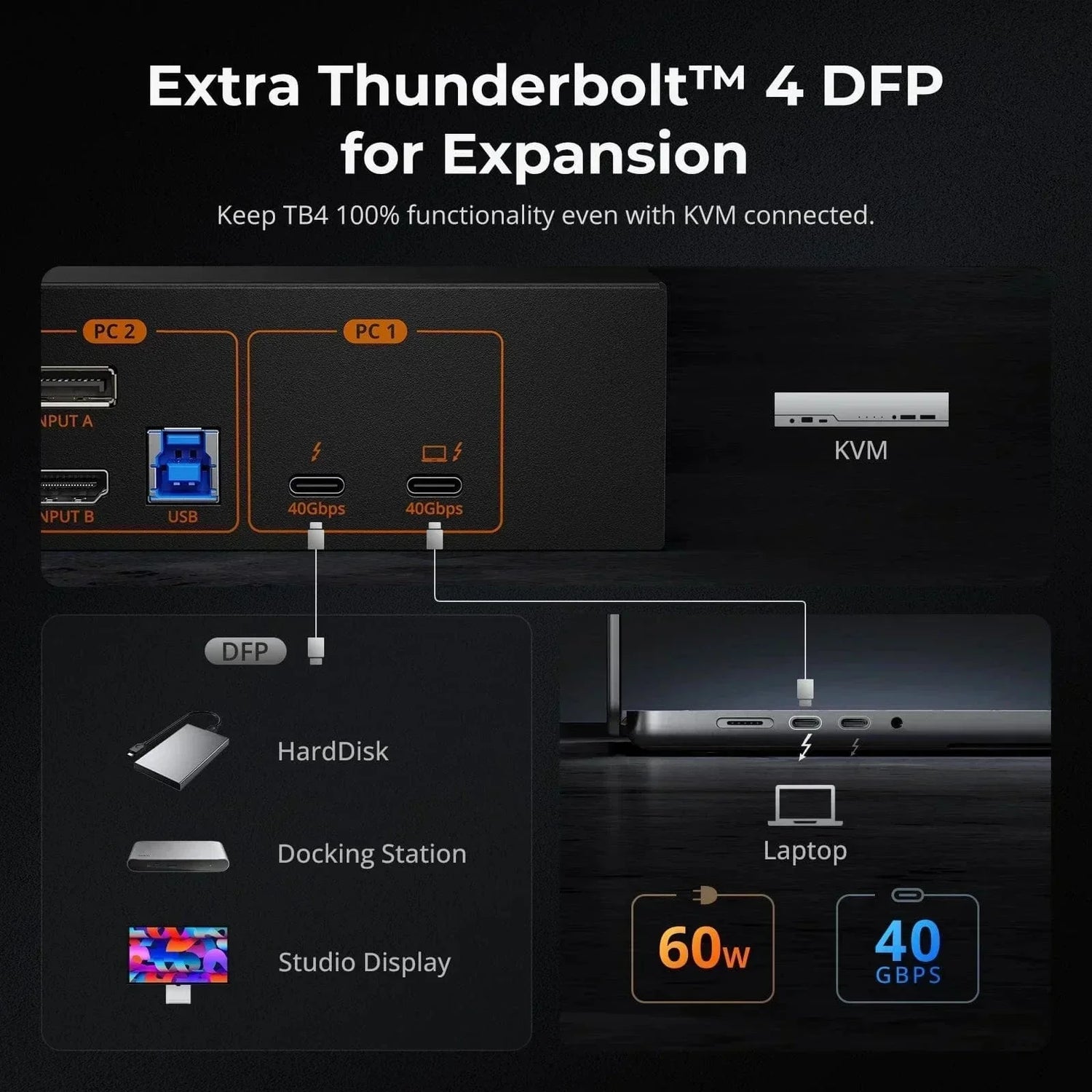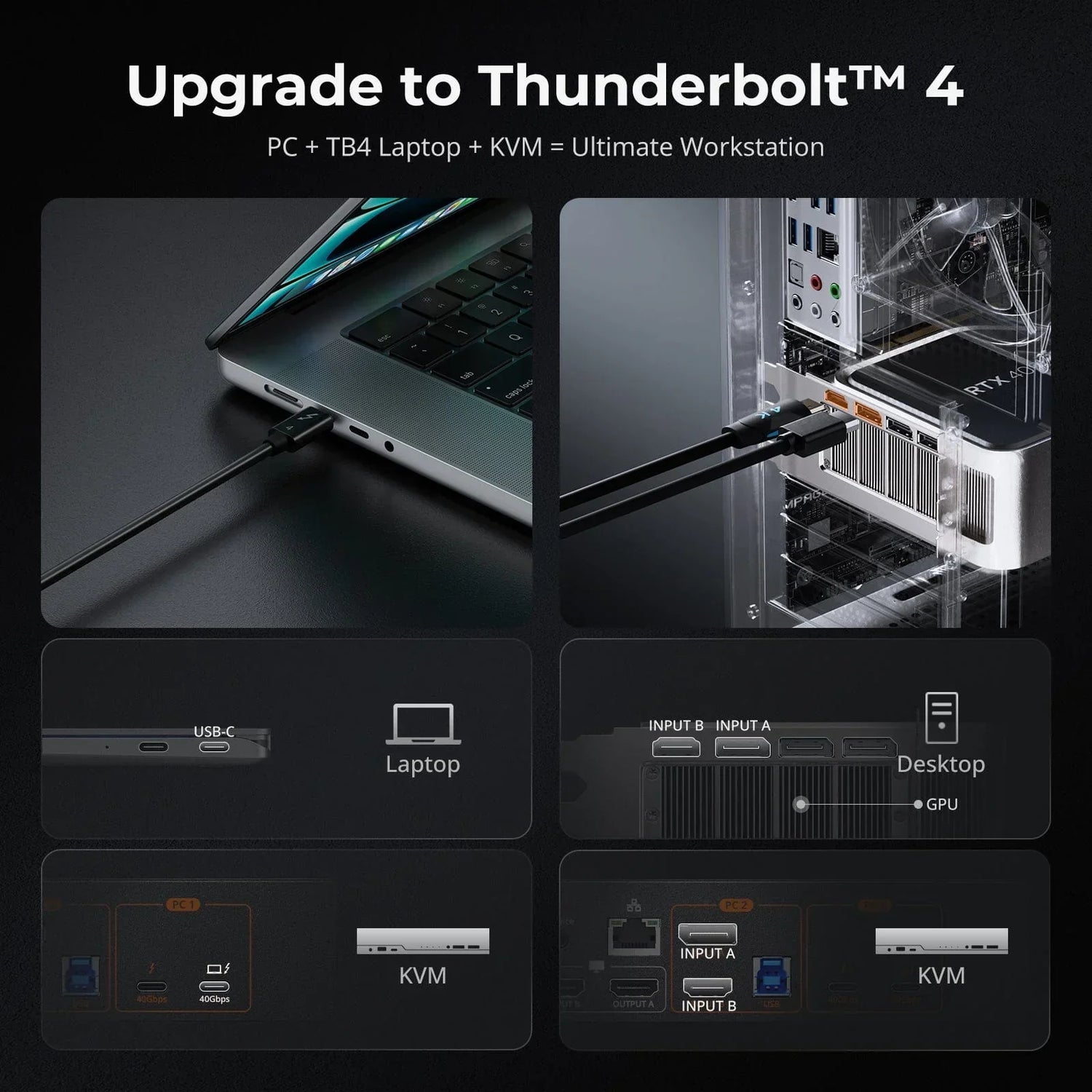Whether you have needs for work or entertainment, both KVM switches and docking stations are common tools used to connect multiple devices and provide a more convenient working environment or gaming experience. In this article, we'll delve into what these devices are, explore their respective advantages, compare their differences, and provide essential insights for selecting the right option to suit your needs.
What is KVM Switch?
A KVM (keyboard, video, mouse) switch is a hardware device that allows users to control multiple computers using a single set of peripherals, including a keyboard, monitor, and mouse. It works by allowing users to toggle between connected computers, redirecting input/output signals to the selected device.
A typical KVM switch generally shares some common features.
- Physical Appearance KVM switches are often rectangular or box-shaped devices, and some models may be rack-mountable for use in server rooms or data centers.
- Connection Methods KVM switches have multiple ports, including VGA, HDMI, DP, etc. for connecting monitors. They also feature USB-A or USB-C ports for connecting keyboards, mice, and other USB peripherals like webcam, headset, printer, or scanner. Users can simply use corresponding cables for connection.
- Control Options KVM switches typically have buttons on the front panel for manually selecting which computer to control. They may also feature LED indicators to show which computer is currently active. Some models offer remote control, hot-key switch or software-based switching options.

What is Docking Station?
A docking station is a device used to connect laptops or mobile devices and provide additional connectivity interfaces and features. Docking stations are kind of like hubs in that they both have more ports. However, docking stations add different connection types. But you can still connect multiple external devices, such as monitors, keyboards, mice, storage devices, etc., to a laptop or mobile device through a single connection point.
A typical docking station generally shares some common features.
- Physical Appearance Docking stations also come in rectangular or box-shaped designs, often with a sleek and compact form factor. Some models are designed to be portable for use in various work environments, while others may be intended for desktop use.
- Connection Methods Docking stations offer multiple ports to facilitate connectivity with various peripherals and external devices. These ports commonly include HDMI, DP, VGA, and other video output ports for connecting monitors or displays. They additionally feature USB-A, USB-C, Thunderbolt, Ethernet, audio, and sometimes SD card reader ports for connecting keyboards, mice, external storage devices, networking equipment, and other accessories.
- Control Options While some docking stations may feature buttons or controls for input selection and settings adjustment, the majority of modern docking stations rely on the connected laptop or computer for control. Users interact with the peripherals through the laptop's operating system, and there's typically no need for manual input selection on the docking station itself.

Scenarios Using KVM Switches&Docking Stations
Working Environment
- Home Offices Individuals with multiple computers or laptops for work-related tasks. For instance, professionals such as stockbrokers, music producers, and IT specialists may require KVM switches or docking stations for tasks ranging from monitoring stock statistics, recording music, to managing multi-platform coding.
- Workspace Tools Employees in positions such as marketing coordinators, graphic designers, and human resources managers often manage multiple computers or laptops for their specialized tasks. These professionals rely on KVM switches or docking stations for diverse activities such as creating marketing materials, designing graphics, and managing employee data efficiently. In company conference rooms or collaborative workspaces, KVM switches or docking stations facilitate efficient sharing of resources among team members, allowing seamless switching between different presenter devices during meetings or presentations.
Entertainment Purposes
- Home Theater AV enthusiasts can effortlessly manage multiple media devices, such as streaming boxes and Blu-ray players, all connected to a single display and audio system. As the centralized control, a KVM switch eliminate the clutter of multiple remotes and simplifies the process of switching between different entertainment sources, whether it's streaming the latest blockbuster movie or enjoying a favorite TV show.
However, docking stations are not typically designed specifically for this purpose. While docking stations can be used for integrating your laptop or mobile device into your home theater setup, they may not offer the same level of functionality and features as dedicated home theater equipment.
- Gaming Territory In gaming, by connecting multiple gaming consoles or PCs, such as PS5, Xbox, and Nintendo Switch, to a KVM switch, gamers can consolidate control of their gaming setups, including monitors, keyboards, and mice. With the press of a button, gamers can seamlessly switch between different gaming platforms, enabling them to explore diverse gaming experiences without the hassle of manually reconfiguring hardware connections.
While docking stations can expand connectivity options for laptops, tablets, or mobile devices by providing additional ports for peripherals, they are generally not equipped to handle the complex requirements of gaming setups involving multiple consoles or PCs.

Differences between KVM Switches and Docking Stations
As technology advances, the functionalities of KVM switches and docking stations increasingly overlap. However, the key difference lies in their primary functions: a KVM switch serves as a centralized control hub for managing multiple input sources, such as PCs or laptops, across one or multiple displays.
A docking station acts more like an enhanced hub for expanding peripheral connectivity for a single input source, be it a PC or laptop.
*While KVM switches and docking stations have overlapping functionalities, their stability in switching differs. KVM switches use separate chips to handle USB data and audio/video data (except for MST), whereas most traditional docking stations use a single chip to decode and separate the data.
Choosing the Right Solution for You
If you need unified control and management of multiple computers and prefer using a single keyboard, mouse, and monitor to switch and operate these computers, a KVM switch is an ideal choice.
If you need to connect multiple external devices to your laptop or mobile device and desire to expand its functionality and connectivity options, a docking station is a more suitable solution.
Conclusion
A KVM switch handles multiple computers or servers with a single set of peripherals, while a docking station expands connectivity options for laptops, tablets, or mobile devices, serving as a central hub for peripherals. Choosing between them depends on your specific needs, work style, and devices used in your setup.
TESmart KVM Switch Recommendations
For Dual Monitors Setup: HKS202-P23 - It supports dual 4K@60Hz displays, allowing efficient management of two computers and two displays with just one keyboard and mouse. The switch offers broad keyboard and mouse compatibility, supporting wired, wireless, mechanical, and gaming keyboards. It provides various switching options, such as hotkeys, front panel buttons, and a remote control, ensuring smooth and convenient operation. Compatible with high resolutions and HDMI 2.0/HDCP 2.2, handling 4K@60Hz, 3440x1440@100Hz, 2560x1440@144Hz, and other high-resolution signals with ease. The package includes complete PC connection cables and supports Windows, Mac, and Linux systems.
For Three Monitors Setup: HKS403-P23 - It comes with multiple USB 3.0 ports (including USB-C with charging functionality), LAN port, and headphone jack. Supporting up to 4 computers and up to 3 shared displays, it offers high-resolution (4K@60Hz) output and broad compatibility (3D, HDR, HDCP, Dolby Vision). The switch provides flexible operation with various switching options and auto-scan feature. One-key locking KVM function ensures privacy protection. The user-friendly LCD visual display offers an intuitive operating experience.


